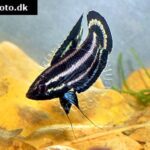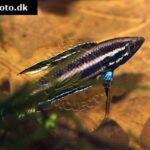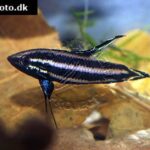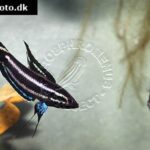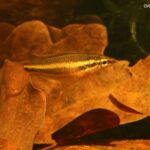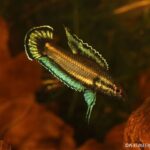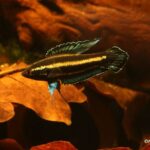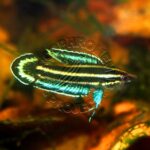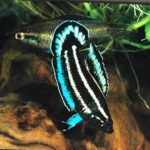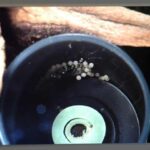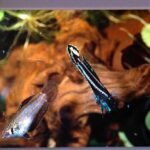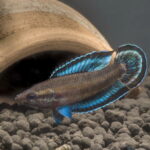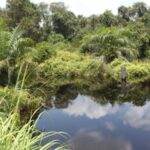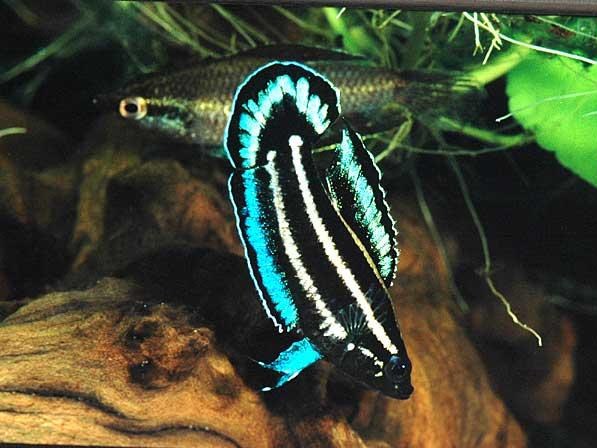
Brown 1987
First description: B. Brown,Special announcement – two new anabantoid species.Aquarist and Pondkeeper, 1987 (June): 34.- Here the same applies as has already been said about the initial description of P. allani (s.d.). This “special announcement” is valid, despite the lack of precise taxonomic information and a stored holotype. However, in 1984 the Browns conserved some specimens, which were classified as “syntypes” by Peter Ng. He and Kottelat selected one of these as a “lectotype in 2005.
Characteristics: Maximum length 4.0 cm. Formulas fins: dorsal XI-XIII, 5-7, total 17-18, anal XI-XIII, 8-11, total 20-22. Round-tail-type. In nuptial plumage the ♂ is distinguished from most of the other round-tailed licorice gouramis (with the exception of some variants of the Bintan complex) by the absence of any red portions in its colour and its striking iridescent blue-green luminescent bands in the unpaired fins. Another characteristic for this species is also the black band at the edge of its tail fin that is wider than in most of the other similar types. The differentiation of the ♀ from the other round tail-type species is problematic as usual. During courtship the female gets the species-typical pale colour while the otherwise glass-clear transparent unpaired fins take on a brownish colour .
Similar species: risk of confusion is low for the males; possibly it can be confused with some variants from the bintan group (e.g. spec. “blue line”). However, usually the differentiation is easy due to the lack of any red or brown colour portion, the fin formula and/or the broad black seam of the caudal fin. The identification of the females is hardly possibly without precise measurements.
Occurrence / Distribution: West Malaysia, type locality Batu Arang. This wetland area is now largely destroyed. The species still exists in suitable remnants of marshes of the formerly large jungle of Selangor (about 100 km north of Batu Arang. No further occurrences are known.
Threat: Very high. After the type locality has been dried up almost completely, de-forested and thus made barely inhabitable for licorice gouramis, the species appears to have adjourned into the formerly extended nature protection area “Selangor Forest”. But despite its protected status this area too has been drained in large parts and has been transformed to plantations. P. Harveyi tries to survive in some of the drainage canals and in remaining black water swamps of the relict jungle.
Discovery/First import: A. und B.Brown to Europe 1984 und 1985.
Trade: The species appeared very rarely in trade; even less frequently after the almost entire destruction of its habitat. Most of the fish, distributed among hobbyists, go back to a few private imports. Because of the risk of confusion with the frequently traded species of the bintan-group (spec. “blue line” etc.), fish labelled as “harveyi” should be examined more closely. On the other hand it has real harveyi may have been traded under the wrong appelation “deissneri” (probably from captive breeding in the hobby?).
Care / Breeding: Typical black water region licorice gourami. pH should not exceed 6.0, but may be at 4.0. Rather low (22 – 24) temperatures (not C 27/28 C degrees!). Conductivity of the water should be definitely less than 100 micro Siemens / cm, KH should not be detectable. Clutches do often not have more then 40 eggs. Foam nest usually consists of only a few bubbles. Not a beginner’s fish.
Behaviour / Particularities: distinct head-down courtship. Good pairs mate, spawn and brood care almost continuously if the conditions are suitable. Medium-size clutches.


